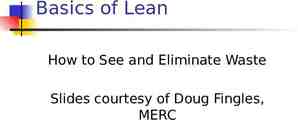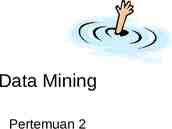U.S. Export Controls How to Comply with Commercial, Dual-Use, and and
36 Slides547.45 KB

U.S. Export Controls How to Comply with Commercial, Dual-Use, and and Defense Article Regulations and U.S. Trade Sanctions EAR / ITAR INTRODUCTION Back to Basics Ammon Hansen – Raytheon Missile Systems Jason Prince – Holland & Hart 1

Disclaimer This presentation, related materials and subsequent discussion are provided for educational purposes only. They do not constitute legal advice nor do they necessarily reflect the views of Holland & Hart LLP or any of its attorneys other than the speaker. This presentation is not intended to create an attorney-client relationship between you and Holland & Hart LLP. If you have specific questions as to the application of the law to your activities, you should seek the advice of your legal counsel. 2

AGENDA Introductions EAR / ITAR Overview Licensing and Commodity Jurisdiction OFAC Compliance Lunch Keynotes Economic Espionage and Theft of Trade Secrets Export Regulations Enforcement Export Control Reform Initiative Update ITAR Registration Requirements (Including ITAR Part 129 Brokering) Export Controls Compliance Programs (Including Key Lists to Check) and Voluntary Disclosures 3

EXPORTS AND INTERNATIONAL BUSINESS U.S. export controls apply to all international business Understanding the regulatory scheme The consequences of failing to comply with the regulations Taking steps to minimize the risk of violations Compliance and risk mitigation 4

REGULATORY ENVIRONMENT Enforcement of export controls is a priority for the U.S. government National Foreign security policy Risk of enforcement varies depending on product/destination Demonstrably effective compliance programs and policies have become a necessity 5

TRAINING AND CORPORATE COMPLIANCE Cost Effective Measure A compliance program designed to protect against inadvertent violations is an effective defensive tool (if implemented) In the event of a potential violation, demonstrable training and good recordkeeping can avert an investigation Avoid expensive legal fees 6

UNDERSTANDING THE CONSEQUENCES Criminal prosecution of executives (up to 20 years in jail). Denial of U.S. export privileges. For foreign companies, violations can result in denial of entry to U.S. market or access to U.S. technology. Debarment from U.S. Government contracts. 7

UNDERSTANDING THE CONSEQUENCES Potential Monetary Penalties in the Millions Commerce Department/Treasury Department o Up to 250,000 civil penalty per violation o 1,000,000 for willful violations (criminal) for corporations (or 5 x the value of the export, whichever is greater). State Department Up to 500,000 per violation 8

WHY YOU SHOULD CARE ABOUT EXPORT CONTROLS In summary: U.S. export control laws are premised on national security and foreign policy Risk of enforcement varies depending on product, international (or domestic) developments Penalties and defense costs can be high 9

ROADMAP TO THE AGENCIES THAT REGULATE U.S. EXPORTS 10

U.S. EXPORT CONTROL LAWS IN GENERAL With whom do we conduct business? What do we export, i.e., services, know-how, data? How do we conduct business? How can we demonstrate compliance? 11

U.S. EXPORT CONTROL LAWS IN GENERAL What’s Covered? Physical commodities, products, components Software Technology / technical data Know-how Services, including training, teaching, etc. 12

THE AGENCIES AND THE REGULATIONS U.S. Commerce Department Bureau of Industry and Security (BIS) Export Administration Act (Expired) International Emergency Economic Powers Act (IEEPA) Export Administration Regulations (EAR) 13

THE AGENCIES AND THE REGULATIONS Export and reexport of: items materials software technology Commercial vs. Dual-Use Denied Persons List, Entity List, Unverified List Antiboycott restrictions 14

THE AGENCIES AND THE REGULATIONS U.S. State Department Directorate of Defense Trade Controls Arms Export Control Act (AECA) International Traffic in Arms Regulations (ITAR) 15

THE AGENCIES AND THE REGULATIONS Export, re-export and temporary import of: Defense Articles Technical Data Furnishing of: Defense Services Debarred Parties List Brokering 16

THE AGENCIES AND THE REGULATIONS U.S. Treasury Department Office of Foreign Assets Control (OFAC) International Emergency Economic Powers Act (IEEPA) Trading with the Enemy Act Foreign Assets Control Regulations 17

THE AGENCIES AND THE REGULATIONS Specially Designated Nationals (SDN) and Blocked Persons List Drug traffickers Terrorists Others Other sanctioned persons lists Many sanctions programs/many different restrictions Comprehensive vs. Targeted ITAR Section 126.1 countries 18

THE AGENCIES AND THE REGULATIONS Other agencies and related controls: U.S. Department of Defense Defense Technology and Security Administration (DTSA) Homeland Security Customs and Border Protection U.S. Department of Energy Nuclear Regulatory Commission There are many other agencies playing different roles in international trade 19

THE ITAR AND THE EAR: STRUCTURE, KEY CONCEPTS, AND DEFINITIONS 20

CLASSIFICATION - ITAR Part Topic Part Topic 120 Definitions 126 General Policies 121 USML 127 Violations/Penalties 122 Registration 128 Enforcement Proceedings 123 Export of Articles 129 Brokering 124 Export of Services 130 125 Export of Data Fees, Commissions and Political Contributions 21

CLASSIFICATION - EAR The U.S. Commerce Control List (CCL) describes items subject to the jurisdiction of the EAR It consists of 10 general categories divided into 5 more specific categories of items A. System Equipment and Components B. Test, Inspection and Production Equipment C. Materials D. Software E. Technology Export Control Classification Numbers vs. EAR99 EAR Section 738 – the Country Chart 22

KEY DEFINITIONS UNDER ITAR AND EAR Export Foreign Person / Foreign National Defense Article / Dual-Use Item Technical Data / Technology Defense Services 23

EXPORT - ITAR Under the ITAR, “export” means: Sending or taking defense articles outside the U.S. in any manner Sending or taking technical data outside the U.S. in any manner Disclosing or transferring technical data to a foreign person whether in the U.S. or abroad The performance of a defense service on behalf of, or for the benefit of, a foreign person whether in the U.S. or abroad 24

EXPORT - EAR Under the EAR, “export” means: an actual shipment or transmission of items subject to the EAR out of the U.S., or the release of technology or software subject to the EAR to a foreign national in the U.S. “Deemed Export” rule “Sending or taking” (ITAR) vs. “actual shipment” (EAR) “Defense services” (ITAR) vs. no mention of services (EAR) 25

FOREIGN PERSON - ITAR The ITAR define “foreign person” as: Any person, including a company employee, who is not a citizen or national of the United States, or who has not been lawfully admitted for permanent residence in the United States Includes all visa holders, including those who are employees of U.S. companies, and U.S. or foreign persons who are employees of foreign companies, international organizations, foreign governments, or any agency or subdivision of foreign governments (e.g., diplomatic missions) Includes corporations and organizations organized in foreign countries 26

FOREIGN NATIONAL - EAR Under the EAR, the equivalent term is “foreign national” Any individual who is not (a) a U.S. legal permanent resident; (2) a U.S. citizen; or (3) a “protected person” under 8 U.S.C. 1324b(a)(3) Different criteria for foreign person / foreign national: Country of birth (ITAR) Country of permanent residence (EAR) Same definition of “U.S. person” under the ITAR and the EAR 27

DEFENSE ARTICLE - ITAR The ITAR define “defense article” as: Any item on the U.S. Munitions List and any technical data directly related to such item It includes “technical data recorded or stored in any physical form, models, mockups or other items that reveal technical data directly relating to items designated in the U.S. Munitions List” It also includes forgings, castings, and other unfinished products, such as extrusions and machined bodies, that have reached a stage in manufacturing where they are clearly identifiable by mechanical properties, material composition, geometry, or function as defense articles It does not include basic marketing information on function or purpose or general system descriptions 28

DUAL-USE ITEM - EAR The EAR control the export and re-export of purely commercial and dual-use items “Dual-use” items are: Items that have both commercial and military or proliferation applications “Dual-use” items present special risks Commodity Jurisdiction Requests may be required to determine if an item is dual-use or a defense article 29

TECHNICAL DATA - ITAR The ITAR define “technical data” as: Information which is required for the design, development, production, manufacture, assembly, operation, repair, testing, maintenance, or modification of “defense articles” (e.g., blueprints, photographs, plans, instructions, documentation) Classified information related to “defense articles” Information covered by an invention secrecy order Software directly related to “defense articles” 30

TECHNOLOGY - EAR The EAR control the release of “technology” to foreign nationals “Technology” refers to: Specific information necessary for the “development,” “production,” or “use” of a product and that takes the form of “technical data” or “technical assistance” Controlled “technology” is defined in the General Technology Note and in the Commerce Control List It is key to understand the defined terms within the definition of “technology” to determine if a license may be required 31

TECHNOLOGY - EAR “Development” is: Related to all stages prior to serial production, such as design, design research, design analyses, design concepts, assembly and testing of prototypes, pilot production schemes, design data, process of transforming design data into a product, configuration design, integration design, and layouts “Production” means: All production stages, such as product engineering, manufacture, integration, assembly (mounting), inspection, testing, and quality assurance 32

TECHNOLOGY - EAR “Use” means: Operation, installation (including on-site installation), maintenance (checking), repair, overhaul and refurbishing “Technical data” may consist of: Blueprints, plans, diagrams, models, formulae, tables, engineering designs and specifications, manuals and instructions written or recorded on other media or devices such as disk, tape, and read-only memories “Technical assistance” may consist of: Instruction, skills training, working knowledge, consulting services, and it may involve transfer of “technical data” 33

DEFENSE SERVICE - ITAR The ITAR define “defense service” as: The furnishing of assistance (including training) to foreign persons, whether in the United States or abroad in the design, development, engineering, manufacture, production, assembly, testing, repair, maintenance, modification, operation, demilitarization, destruction, processing or use of defense articles; The furnishing to foreign persons of any technical data, whether in the United States or abroad; or Military training of foreign units, whether in U.S. or abroad Again, the EAR do not mention the term “defense service” 34

EXPORT CONTROL REFORM Harmonization of Key Definitions Department of State and Department of Commerce review/harmonization of key terms in the ITAR and the EAR, including: Technical Data Technology Public Domain Fundamental Research Electronic transmission and storage of data (cloud computing) STATUS – Under Review / Proposed Rules 35

QUESTIONS? 36






